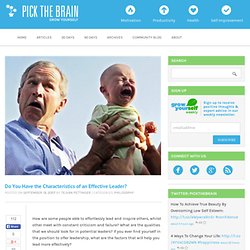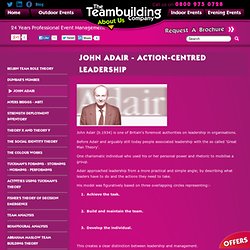

Do You Have the Characteristics of an Effective Leader? How are some people able to effortlessly lead and inspire others, whilst other meet with constant criticism and failure?

What are the qualities that we should look for in potential leaders? If you ever find yourself in the position to offer leadership, what are the factors that will help you lead more effectively? The following characteristics will help you estimate the leadership ability of others and become a better leader yourself. Inspire not Command. “A leader is best when people barely know he exists, when his work is done, his aim fulfilled, they will say: we did it ourselves.” – Lao Tsu The best leader will inspire his followers. Have Confidence and Belief. Confidence and belief are essential for effective leadership.
Be willing to admit Mistakes. A good leader needs the strength to ignore criticism. Delegate Where Appropriate. “Leadership: the art of getting someone else to do something you want done because he wants to do it.” A good leader cannot do the jobs of several people. Horton.pdf (application/pdf Object) Leadership Characteristics.pdf (application/pdf Object) Top 10 Characteristics of An Effective Leader. Comments (16) Share: [Updated October, 2012 by Kristin Zhivago] Every business needs an effective leader.

Highly effective leadership is rare. Here's my checklist, which comes from helping hundreds of CEOs, entrepreneurs and managers become more effective leaders. The Top 10 Characteristics of An Effective Leader 1) Is Truly Humble - Leads to Serve 2) Is Non-Judgmentally Observant 3) Faces and Solves Problems 4) Ruthlessly Improves 5) Is Fiscally Conservative 6) Invests in the Business 7) Communicates Regularly, Clearly, and Purposefully 8) Gives Clear Direction 9) Evolves Agressively 10) Has a Sense of Humor (11) Bonus Characteristic: Is Customer-Centric Here's why the list contains what it contains: 1) Is Truly Humble - Leads to Serve No one likes to work for a jerk or buy from a jerk.
A real leader lives to help others. Effective_Team.pdf (application/pdf Object) Six Characteristics of Highly Effective Change Leaders. How do you cultivate a culture of learning, adapting, and leading in your organization?

In today’s rapidly changing business environment, quickly identifying new opportunities and taking action to capture them is no longer the private domain of industry leaders—it is a matter of survival for every business and for every employee. As Pulitzer prize-winning author Thomas Friedman noted in his book, The World is Flat, not just every company, but every individual is competing today in a global economy.
Today’s landscape is a Darwinian world. The winners and losers of this global competition are determined by one factor: change. Today’s competitors are moving so fast, that products and jobs get quickly commoditized or even eliminated. It is worth noting that learning how to learn, learning how to innovate, and learning how to change are all closely related. While being a change leader may not be easy, the first step is knowing what it requires. 1) Low Level of Anxiety. The Six Surprising Habits of Today's Highly Effective Leaders. Untitled.
How You Can Be An Effective Leader. Table of Contents Introduction.

3 characteristics of an effective team leader. Effective Team leaders. Ten Qualities of an Effective Team Player. If you were choosing team members for a business team in your organization, who would the best team players be?

Assuming that people have the right technical skills for the work to be done, what other factors would you use to select your team members? Teams need strong team players to perform well. But what defines such people? Read on. (Also, check out How to Hire the Best Brains for the Best Team for some tips on putting a team together.) Demonstrates reliability You can count on a reliable team member who gets work done and does his fair share to work hard and meet commitments. Communicates constructively Teams need people who speak up and express their thoughts and ideas clearly, directly, honestly, and with respect for others and for the work of the team. Listens actively Good listeners are essential for teams to function effectively. Functions as an active participant Good team players are active participants.
The Qualities of an Effective Team Leader.pdf (application/pdf Object) Adair.pdf (application/pdf Object) Adairs Action-Centred Leadership Model. Action centered leadership, (john adair's action-centred leadership model) The three parts of Adair's Action-Centred Leadership model are commonly represented by three overlapping circles, which is a trademark belonging to John Adair, and used here with his permission.

Adair's famous 'three circles' model is one of the most recognizable and iconic symbols within management theory. When you refer to this diagram for teaching and training purposes please attribute it to John Adair, and help preserve the integrity and origins of this excellent model. John Adair's Action-Centred Leadership model is represented by Adair's 'three circles' diagram, which illustrates Adair's three core management responsibilities: achieving the task managing the team or group managing individuals. John Adair Team Theory. John Adair (b.1934) is one of Britain's foremost authorities on leadership in organisations.

Before Adair and arguably still today people associated leadership with the so called 'Great Man Theory'. One charismatic individual who used his or her personal power and rhetoric to mobilise a group. Adair approached leadership from a more practical and simple angle; by describing what leaders have to do and the actions they need to take. His model was figuratively based on three overlapping circles representing:- Achieve the task. This creates a clear distinction between leadership and management. Creating charismatic 'Great Man' leaders is difficult and cannot be relied on. You cannot guarantee that such a person can be developed and, once developed, that they will be reliable.